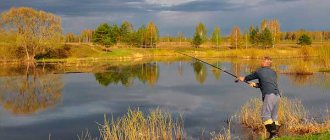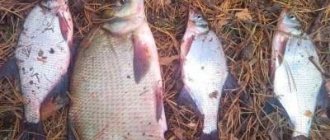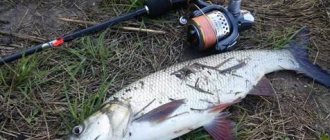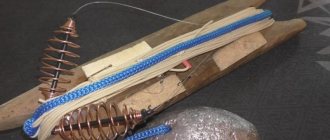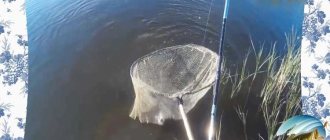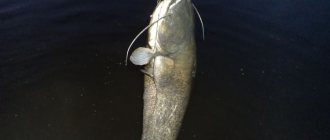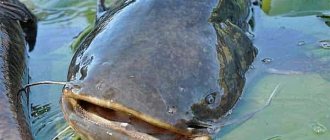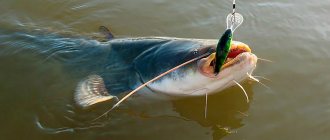Catching catfish at any time of the year is a real challenge, because catching this fish requires remarkable skill, experience and a certain amount of knowledge. If you have these qualities, then you will very soon fall into your hands. However, it is better to catch it not with your hands, but with bottom tackle, because this is the most effective and reliable way. It is better to put aside even the universal spinning rod in many ways. In the article we will cover the topic of catching catfish in the spring with a bottom and a hook, namely, how to catch catfish from the shore and boat, what to use as bait and, of course, how to make bottom equipment with your own hands.
Change in bite depending on the season
When choosing the best time of year for fishing, it is worth considering the biological clock of the predator:
- Late autumn – mid spring. At this time, trying to catch a river giant is a useless task and doomed to failure. And although it would seem that on the eve of the winter cold the fish should eat in order to gain weight, this does not happen. The fact is that a decrease in water temperature, as well as a reduction in daylight hours, force the catfish to save strength and energy. In winter, the predator goes into suspended animation and completely stops feeding. With the onset of spring, fish begin to swim out of the holes to prepare for spawning. However, you shouldn’t expect a stable bite until the water warms up.
- Late spring – early autumn. In May, the catfish begins to prepare for spawning and a stable bite can be observed, but in June it stops completely, as mating games and egg laying begin. July and August are the best time for fishing. Having spawned, the predator begins to actively feed, even during the daytime. In early autumn, the bite slows down: the fish begins to prepare for hibernation.
Catching catfish in April
Catfish fishing in early spring begins in mid-April, provided that the water has already warmed up to 10 °C. To determine the temperature, it is not necessary to have a thermometer - water is 3-4 °C colder than the outside air.
At this time, you can fish with almost all baits, but only daytime fishing is effective, night fishing does not give results.
During this period, catfish are characterized by wariness, so they do not swim far from the holes; in rare cases, if the day turns out to be very warm, they are likely to be in the shallows.
Conditions for the best bite
Times of Day
Catfish are considered a purely nocturnal predator, but this is not entirely true. The fact is that fishing at different times of the day is different from each other.
- From dawn to dusk. During the day, the catfish prefers to hide in pools and snags, but this does not mean that it cannot be fished out. Catching a river giant during daylight hours requires a lot of energy and physical effort. Catfish lie motionless at the very bottom, and the fisherman, in the literal sense of the word, has to look for a predator. The most successful options are spinning and quok fishing. For the first, you need a heavy bait in the form of a large fish or crayfish. This is due to the fact that the spoon will sink to the bottom faster, thereby allowing large volumes of river depths to be plowed. Fishing with a quok is more successful, as it recreates the sounds of the predator’s favorite delicacy – the frog. However, it becomes more difficult to pull out a more or less decent specimen, since fishing is carried out from a boat and a good catfish can roll you around the pond for a long time.
- From dusk to dawn. With the onset of dusk and before the first rays of the sun, the fish swim out of their holes and begin to actively feed. With the help of long whiskers that capture any, even the faintest odors, the predator begins to plow the bottom in search of prey. That is why donks are the best gear for catching it.
Weather
This factor influences the bite to a lesser extent, but one cannot ignore some important observations made by both amateurs and professionals.
- Strong wind. This natural phenomenon not only spoils the mood of fishermen, but also reduces the likelihood of a bite, as extraneous noises appear that frighten the predator.
- Heat. Most preferred weather factor. This is due to the fact that the water temperature rises, and the catfish begins to actively feed even in the daytime.
- Rain. Drops falling from the sky drop insects and small animals into the water, which undoubtedly entails bites from any other predator, but not catfish.
- Moderate weather. According to most anglers, this is the best time to fish, and not because the fish bite better, but because fishing begins to bring real pleasure.
Pressure
Ichthyologists still don’t know why fish bite depends on changes in atmospheric pressure. However, it would be foolish to deny that mercury readings cannot warn an angler about an empty bag and an untouched hook.
- Steadily increasing pressure. Despite the general opinion that there is no need to expect a bite at this time, the catfish continues to actively feed on its usual schedule.
- Stable high blood pressure. It slightly impairs the success of fishing, but not catastrophically.
- Stable low pressure. It is the preferred period for fishing, as small fish begin to actively feed. What entails bites.
- Steadily decreasing pressure. The most successful option for catching any fish, as it becomes the most active and voracious.
- Spasmodic pressure. The biting at this time practically stops, as the fish begins to get sick and stops feeding.
Temperature
The activity of catfish, and therefore the success of catching it, directly depends on temperature.
- High temperatures provoke the activity of the predator; it is not without reason that the best time for fishing is July and August.
- Low temperature forces the fish to save strength and energy. Sometimes, at the first frost, the bite stops completely, as the fish goes into suspended animation and stops responding even to the most attractive baits.
Fishing place
Choosing a place is perhaps the most important preparatory moment for catfish fishing. You can’t just cast a fishing rod and wait for the weather by the sea; it’s important to know where the river predator lives.
- Wintering pits. Catfish prefer to hide in large, deep holes, away from sunlight and external threats, therefore placing gear in such places is most effective.
- Edges of holes, cliffs. When swimming out to hunt, the predator first of all inspects the bottom around its rookery.
- Quarries and depressions.
- Shallow water. In the summer, especially after spawning, when the water warms up, the catfish swims into shallow water, since this is where the small fish on which it feeds go.
Bait
Catfish is a voracious predator, possessing a huge powerful mouth that can straighten forged hooks, it feeds on everything that swims by, mollusks, crayfish and so on. However, like any other fish, it has its own preferences.
- Frogs are perhaps his favorite food.
- Crawls. They attract predators with their size and smell.
- Live bait. Almost any fish caught in the body of water where you are fishing.
- Fried sparrow. Catfish are attracted to the smell of burnt skin and feathers, so the bird should be scorched immediately before casting for greater effect.
- Small rodents. The least common fishing option, however, is no less effective.
What to fish with
These fish eat anything that is in front of their whiskers and fits into their mouth. Not only various fish and insects, but also birds, frogs and rodents were found in the stomachs of large catfish. They can eat crayfish and crabs.
The diet of catfish usually depends on their size.
Small catfish (up to one meter) usually feed on:
- invertebrates such as snails, insect larvae;
- small crustaceans;
- everything edible that can be found at the bottom, including dead fish, birds, rodents.
Large catfish (more than a meter) eat everything and actively hunt large fish, birds, rodents, crayfish and crabs.
Lures for bottom fishing
Suitable for fishing are live and dead fish from the family of carp, perch and other species that live in its reservoir.
Fish scraps, dead fish, and large bunches of manure worms work best.
We recommend: Asp, where to look, how to catch
Try using dead squid or octopuses that are not fresh (with a slight odor), you can try catching them with the liver.
Many catfish prefer large baits, bait with bunches of worms or several carcasses.
Spinning baits
It makes sense to catch catfish with artificial bait only in bodies of water where there are a lot of other fish and it is constantly included in its diet.
The size of the bait must be selected based on the size of the expected prey. Lures should be large in size based on the size of the prey, but not more than 30 cm.
The color of artificial baits does not matter when catching catfish; it practically does not use vision for prey, but uses other senses.
When fishing with artificial bait, you should use the following tactics. If the catfish is active, it likes to rise from the bottom to the upper layers of water and look for its prey there. Therefore, fishing must begin from the surface, gradually descending to the bottom.
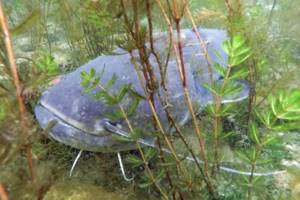
To lift catfish from the bottom, a special device, a quok, is often used. By hitting it on the surface of the water, it imitates the sounds of fish and other living creatures feeding from the surface, causing interest in large catfish and causing them to rise from the bottom.
Share link:
Dependence of the bite on the gear used
You can fish with a variety of gear, but the most popular are the following options:
- Donka. The most effective fishing method in summer. When choosing equipment, it is important to consider that the catfish is quite large in size. Therefore, the strength of the fishing line must be appropriate. Some anglers even use a clothesline. The feeder is optional, but if desired, you can fill it with a mixture of worms, maggots, bloodworms and fish offal.
- Spinning. Just as with bottom fishing, it is necessary to take into account the size of the predator. A light spinning rod will be broken without hesitation, and a thin fishing line will be torn. It is best to use a strong cable with a steel leash. For bait, use a large wobbler or a heavy spoon.
- Kwok. The most common and cheapest fishing method. A reel with a rope or cable is used as gear. Steel leash. Unlike other types of fishing, this can be considered the safest, since the maximum that you are in danger of is an overturned boat, and in this case, you must be wearing a life jacket.
Where can you catch catfish?
This question is one of the main ones for the fisherman, because you can’t just set up a fishing device and wait for an excellent result. Fish such as catfish should be bited only in certain places.
Among these are:
- depth. Typically, predator fish try to stay in this part of the water bodies. Catfish loves warm living conditions, so you will never see them in small, cold rivers;
- pools and deep ponds that are quiet;
- quarries, cliffs, depressions;
- in summer it is possible to live in shallow water;
- It is possible to swim close to the shore to catch frogs.
For such places, it is best to choose a fishing method from the shore. But if the weather is cool, then catfish will hunt only in the depths. Catfish can appear for feeding near steep banks, in pools, in trees and bushes above the water.
Why it doesn’t bite and how to improve the bite
There are a lot of reasons for the lack of bite. Some of them are simple and banal, others are related to the intricacies of the biological rhythm of a reservoir. Below are the most common ways to improve the bite.
- Disguise. Fish is not a stupid creature, and often notices suspicious objects on the shore and on the surface of the water. To increase your chances of getting a bite, wear clothing that allows you to blend in with the area, remove bright objects from the shore, and re-cast your fishing rod.
- Bait. Try playing with the bait, use different fishing options, don’t be afraid to experiment.
- Tackle. Some rods are too stiff and rough, making the bite difficult to notice.
- Loud sounds. Fish loves silence, so you should be as quiet as possible.
- Bad place. It is quite possible that the places where your fishing rods are thrown are simply empty and, for various reasons, are not visited by large predators.
How to catch catfish on a donk from the shore (2 options and fishing technique)
- Fishing technique using coastal bottom tackle with a rod during the pre-spawning period.
Catching catfish using this technique gives good results in the spring , especially in May, during the pre-spawning period, when the water temperature in the reservoir is at least +16°C.
- Determine the location. During this period, this is easy to do, since the catfish actively moves in shallow waters.
- Place the rod on a strong support and tie it to a stake driven into the ground.
- Loosen the reel clutch to avoid line breakage in case of a possible jerk.
- Provide your gear with an audible bite indicator in the form of a bell or an electronic alarm.
- Use enzyme-based baits or a feeder with a combined animal and plant composition in a ratio of 70% to 30%.
- Wait for the bite; as soon as it happens, hook it immediately.
- Start fishing.
- Classic fishing technique without a rod.
Article on the topic: Trolling catfish
This technique is very effective when catching large specimens and consists of the following steps.
- In warm, pre-storm cloudy weather, secure several classic donks on the shore using carved homemade spears stuck in the sand. Rogatins, with this technique, also perform the function of a reel.
- Make the tackle from a greenish cord and provide it with a float to control the bait.
- Secure the butt of the tackle with a carabiner to the tree trunk
- Thread the bait in a bunch. You should have several different baits in your arsenal.
- Throw the tackle and pull towards you until the slack in the cord is eliminated and a depth of 2 meters is reached.
- After casting, attach any available bite alarm.
- Put on gloves and, having noticed a bite, start pulling out - if the fish suddenly moves away, lower the line a little and then hold it, trying to reduce resistance and fatigue.
- Drag the catch closer to the shore and take it into the landing net.
- A large specimen should be taken under the gills with a hook and stunned.
The table shows the equipment for both techniques.
| Type of fishing line | Main line, mm | Leash, mm | Leash length, cm | Type of sinker | Load, g | Hooks, no./piece | |
| I | monofilament | 0,5-1 | 0,4-0,8 | 100-150 | Standard, sliding | 100-150 | 10-40/ 2,3 |
| Wicker | 0,5-0,8 | ||||||
| II | Twisted cord | 0,7 | 0,6 | Deaf | At least 50 | 10-40/1 |
Blitz tips
- Talk to local fishermen; they probably know the location of wintering pits, quarries and craters. Detailed knowledge about the place of your future fishing can be a great help for regular biting.
- Pay attention to splashes, circles on the water, as well as birds circling over the surface of the water. The fact is that predators, as a rule, move after their prey, the location of which can be determined by the above characteristics.
- Analyze the inhabitants of the reservoir in which you will be fishing. This will increase the chances of a bite, since predators prefer to eat familiar food rather than foreign sweets.
- Look at the current speed and depth. Catfish prefer deep, calm pools.
- When hunting a predator at night, take all precautions, remember, there are many fish in the water, your life is one.
Groundbait and bait
Bait for catching catfish is not used so often. It makes sense to feed fish when the body of water where you went fishing is unfamiliar to you. Having discovered food in a certain place, the predator will remain nearby for a long time.
Bird offal can be used as bait: stomachs, liver, as well as meat and seafood. It is best to fry them or smoke them.
Catfish will not refuse crayfish, mussels, frogs, small fish, which you can catch in the same reservoir.
It is worth paying attention to the fact that baiting is much easier than feeding . To do this, you need to scatter the food for several days.
As bait, it is recommended to use ordinary earthworms, which need to be hidden in pieces of turf. Catfish like the hooves and horns of livestock, and bird feathers that have been burned at the stake. Subsequently, they can be used as attachments.
In addition, the river predator is also attracted to large shells.
What bait does he bite on?
Catfish eat almost everything. Based on this, the list of baits and baits that he bites is very diverse and large. But there are also undisputed favorites.
When choosing bait for hunting catfish, it is necessary to take into account the fact that this fish has very poor eyesight, it is nearsighted and relies solely on its excellent sense of smell, acute hearing and sensitivity of the lateral line, which allows it to sense the slightest fluctuations in the water. Therefore, the bait must smell and move.
The omnivorous nature of catfish provides the fisherman with a wide choice of baits. All of them are divided into artificial and natural.
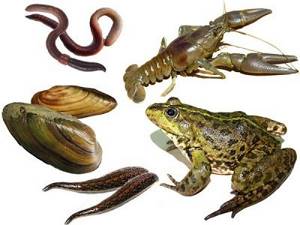
- The best natural bait is live bait: chub, asp, herring, sabrefish, carp, pike perch, perch;
- Frog;
- Small crayfish with a still soft shell;
- Locust, mole cricket;
- Shellfish meat;
- Pearl barley meat;
- Leeches, worms, caterpillars, which need to be strung in a bunch.
As artificial baits, you can use line, deep-sea wobblers, jig . Large and heavy tackle for catfish will allow you to catch it in deep holes and pools.
The range of baits is huge, which allows you to experiment.
It is important to remember that the bait for catfish should be related to the size of the desired prey - a quarter or an eighth of the carcass. The larger the bait, the larger the fish that will bite on it.
What do catfish bite on in July?
In July, catfish will bite best on live bait . It is in the second month of summer that numerous juveniles of various carp fish (mainly carp) appear in the rivers and the feeding intensity of catfish increases significantly.
What do catfish bite on in August?
In summer, the fresh water body is full of catfish’s favorite food.
In the last month of summer, fish bite well on:
- small live bait;
- for shellfish meat;
- frogs, leeches;
- on waterfowl;
- for large locusts.
Look at the answer to the question what pike bites on.
